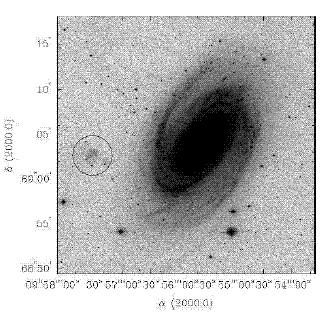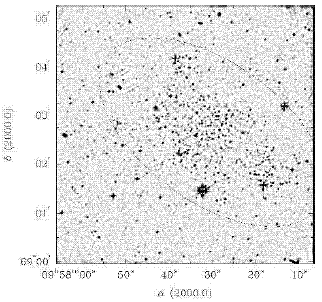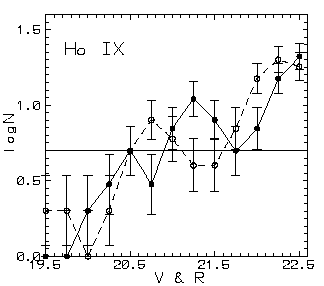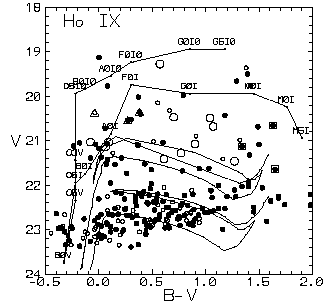Photometry
of nearby late-type dwarf galaxies:
structures,
stellar populations, evolutionary status
The
goal of this subproject is an
investigation of the structures, stellar populations mix, and star
formation
history in nearby late-type galaxies, members of the Local Group and
groups of
IC 342, M 81 and others.
Observations of star formation activities provide a clue to
studying the
evolution of galaxies, as well as understanding the Hubble sequence.
Active
star formation takes place in spiral and irregular galaxies. It is a
common
point of view that spiral density waves play an important role in star
formation in large disk galaxies. That's why dwarf irregular galaxies
(DIGs),
that are in many cases isolated star formation sites, without spiral
arms, are
interesting laboratories for studying star formation processes
triggered by
mechanisms other than spiral density waves.
The DIGs have low luminosity, mass, size and metallicity.
Detailed
studies
of these objects are in progress
in the last two decades, but only in the last years it has become a
fashionable
research field. This is probably due to the growing acceptance that
understanding of the evolution of the gaseous and stellar constituents
of these
systems is necessary step for a correct interpretation for the
processes of
galaxy formation and evolution, and the evolution of the intergalactic
medium.
Several key questions about the structure and evolution of DIGs
come up
(see e.g. Bomans et al., 1995, Hunter 1997, Grebel 2000, Tolstoy 2001,
and
references therein). Why the range of the star formation rate (SFR) is
larger
among many irregulars then the spiral galaxies? What feedback processes
are
operating to regulate the star formation on local and global scale?
What role
does the interstellar medium play in the evolution of irregular
galaxies? The
connection between the late-type dwarfs and the cosmology is at least
three-fold: 1) the high gas content and the low metallicity of these
galaxies
makes them closest analogous to the primeval galaxies; 2) they provide
the
empirical determination of the primordial He abundance; 3) star
bursting dwarfs
are local counterparts of the large population of blue galaxies at
intermediate
redshifts. Finally and foremost, the star formation histories of dwarf
galaxies
are the direct fossil record of the star formation processes in the
early
Universe.
Many searches for faint and low surface dwarf galaxies has been
carried
out in the last years. As result, recently supplemented catalogs
contain about
600 galaxies in the Local Volume (D < 6 Mpc). (see f.e. Karachentsev
et al.
2000). The most of these galaxies are dwarfs, discovered in the last
decade,
without detailed photometric studies yet.
The investigations up to know clearly showed that dwarf galaxies
are
complex systems with diverse properties. Therefore a large sample which
allows
to sample environmental effects and explores the possible intrinsic
breadth in
global parameters is needed to draw reliable conclusions on the
cosmological
parameters. In all cases this information is an enlargement of the
knowledge of
the galaxies in the nearby Universe. The stellar photometry may add
information
about the supergiant stars and the photometry of diffuse objects -
about the
star clusters and assotiations.
Our goals include determination of its fundamental observables,
based on
surface photometry and, in favorable cases, analysis of the
color-magnitude
diagrams (CMDs) of the resolved objects. CMDs allow estimate the
reddening, the
distance and the age of the last star formation event. The estimation
of the
reddening is especially important in the case of the group IC 342,
observed
through the Milky Way. The data from the surface and stellar photometry
also
give clear hints at the metallicity and the star forming history with
deep
observations and/or with use of special filter sets. The observing
material for
the project is broad band CCD frames from own ground based observations
(already observed and to be proposed), as well as archival HST
observations.
One
investigation of the dwarf galaxy Ho IX is presented here after
Georgiev &
Bomans (2004). The appearances of this galaxy in POSS2 and in the
residual
frame of the 2 m telescope of the Rozhen NAO are shown in Fig.1 and
Fig.2. The
photometry of 232 star like and 11 diffuse objects is performed by
means of
Rozhen software. The slope ~0.6 of the luminosity function of the bue
stars,
shown in Fig.3, gives evidence that HoIX is a typical star-forming
dwarf
galaxy. The color-magnitude diagram and the isochrones in Fig. 4 show
that the
last very active star formation period in Ho IX takes place before
30-40 Myr.
In the present epoch the star formation process continues with low rate.
Fig.
1. A 30’x30’ blue print of the digitized POSS2 where HoIX is a faint
spot near
the big spiral galaxy M 81 (in the circle).
Fig.
2. A 5’x5’ frame of HoIX (in the ellipce), observed with the 2 m
telescope of
the Rozhen NAO down to 23.5 mag and with ~ 1.2” resolution
Fig.3.
The luminosity function of the
blue stars with (B-V)<0.5 in B band (solid) and in R-band (dashed).
Fig.4.
The color-magnitude diagram
with the sequence of the MW supergiants (two upper curves) and 20 and
40 Myr
isochrones for Z=0.004, shifted with B extinction 0.32 mag and distance
modulus
27.7 mag.



